Original title: Black or White?
Author: Arthur Hayes, founder of BitMEX; Translated by: 0xjs@ Jinse Finance
When asked about his pragmatic approach to implementing China’s economic system, former Chinese President Deng Xiaoping once famously said: “It doesn’t matter if the cat is black or white, as long as it catches mice, it’s a good cat.”
If you’ve ever heard Kamala Harris speak without a teleprompter, you know what I’m talking about. Similar sophistry is practiced in the land of “freedom,” pickup trucks, and Doritos. I want to offer my thoughts on a malleable economic “ism” in the Pax Americana economic system. I will call the current policies being implemented by Trump fans and newly elected President Trump American capitalism with Chinese characteristics.
The elites who ruled the Pax Americana did not care whether the economic system was capitalist, socialist, or fascist, but whether the policies implemented helped them retain power. The United States ceased to be a purely capitalist country in the early 19th century. Capitalism meant that the rich would lose money if they made the wrong decisions. This was outlawed as early as 1913 when the Federal Reserve was founded. As privatized gains and socialized losses weighed on the country and created an extreme class divide between the many deplorable or sleazy people who lived in the interior and the upright, respectable, sophisticated coastal elites, President Franklin Roosevelt had to correct course and distribute some crumbs to the poor through his New Deal policies. Then, as now, expanding government relief for those left behind was not a policy that was popular with the wealthy so-called capitalists.
The pendulum swung back from extreme socialism (in 1944, the top marginal tax rate on those earning over $200,000 was raised to 94%) to the unfettered corporate socialism that began in the Reagan era in the 1980s. Since then, neoliberal economic policies of central bank money printing, handing money to the financial services industry in the hope that wealth would trickle down from the top, were the status quo before the 2020 coronavirus pandemic. President Trump responded to the crisis by channeling his inner New Dealer; he handed out the most money since the New Deal directly to everyone. In 2020-2021, the United States printed 40% of all dollars in existence. Trump started the stimulus check party, and President Biden has continued the welcome handouts during his term. When assessing the impact on government balance sheets, a strange thing happened between 2008-2020 and 2020-2022.
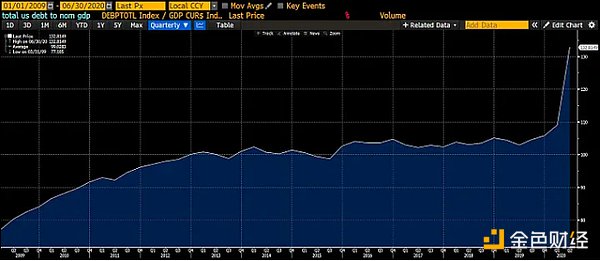
2009 to Q2 2020 was the peak of trickle-down economics, funded by central bank money printing and euphemistically called quantitative easing (QE). As you can see, the economy (nominal GDP) grew slower than the debt accumulation at the national level. In other words, the wealthy spent their government windfall on assets. These types of transactions did not generate any real economic activity. Thus, the distribution of trillions of dollars of debt funding to wealthy financial asset holders increased the debt-to-nominal GDP ratio.
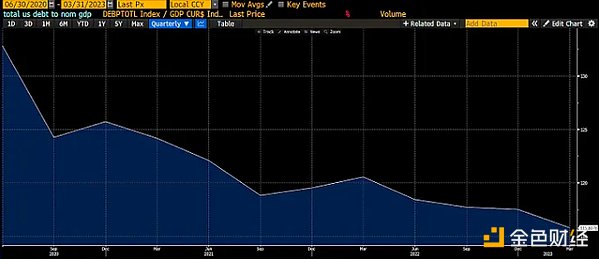
Presidents Trump and Biden bucked the trend from Q2 2020 to Q1 2023. Their Treasury issued bonds, which the Fed bought with printed dollars (QE), but instead of sending bonds to the rich, the Treasury mailed checks to everyone. The poor had real cash in their bank accounts. Apparently, Jamie Dimon, CEO of JPMorgan Chase, got a cut of the transaction fees on the government transfers… He’s the Li Ka-shing of America; you can’t get away from paying this old guy. The poor were poor because they spent all their money on goods and services, which is exactly what they did during this period. With the velocity of money well over 1, economic growth boomed. That is, $1 of debt created more than $1 of economic activity. So, magically, the ratio of US debt to nominal GDP fell.
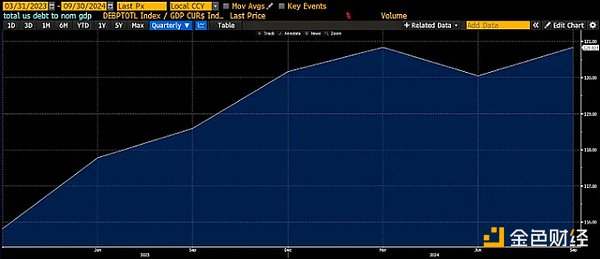
Inflation is rampant because the supply of goods and services is not growing as fast as the purchasing power of the public financed by government debt. The rich who own government bonds are not happy with these populist policies. These rich bond holders have been hit with the worst total return since 1812. The rich sent their prince charming, Federal Reserve Chairman Jay Powell, to fight back. He began raising interest rates in early 2022 to control inflation, and while the public would have liked another round of stimulus, such policies were prohibited. US Treasury Secretary Bad Gurl Yellen stepped in to undo the impact of the Fed's attempts to tighten monetary conditions. She exhausted the Fed's reverse repurchase facility (RRP) by shifting debt issuance from the long end (coupons) to the short end (bills). This provided nearly $2.5 trillion in fiscal stimulus, mainly benefiting the rich who have held financial assets since September 2002; asset markets have boomed as a result. As after 2008, these government largesse has not generated any real economic activity, and the ratio of US debt to nominal GDP has begun to rise again.
Has the new Trump administration learned the right lessons from recent American economic history? I believe it has.
Scott Bassett, whom most people think will be Trump’s pick to replace Yellen as Treasury Secretary, has given many speeches about how to “fix” America. His speeches and op-eds detail how to implement Trump’s “America First” plan , which bears a strong resemblance to China’s development plan (which began with Deng Xiaoping in the 1980s and continues today). The plan is designed to boost nominal GDP by providing government tax credits and subsidies to reshore key industries (shipbuilding, semiconductor factories, auto manufacturing, etc.) . Qualifying companies will receive cheap bank financing. Banks will once again scramble to lend to real companies because their profitability is guaranteed by the U.S. government. As companies expand within the U.S., they must hire American workers. Higher-paying jobs for ordinary Americans means more consumer spending. The impact will be further amplified if Trump limits the number of sombrero-wearing, cat-eating, dog-eating, dark-skinned, dirty immigrants crossing the border from “shithole countries.” These measures stimulate economic activity, and the government is funded through taxes on corporate profits and wage income. The government deficit must remain large to finance these programs, and the Treasury finances the government by selling bonds to banks. Banks can now rebalance their balance sheets because the Fed or lawmakers have suspended the supplementary leverage ratio. The winners are ordinary workers, companies producing "permitted" products and services, and the U.S. government, whose debt-to-nominal GDP ratio has fallen. This is QE on steroids for the poor.
Wow, that sounds good. Who could argue with such a magical era of prosperity in the United States?
The losers are those who hold long-term bonds or savings deposits. This is because the yields on these instruments will be intentionally controlled below the nominal growth rate of the US economy. People will also lose if wages do not keep up with higher inflation levels. If you haven't noticed, joining a union has become cool again. 4 and 40 is the new slogan. That is, pay workers 40% more wages, or 10% raises per year, for the next 4 years to stay on the job.
For those of you who think you are wealthy, don't worry. Here is a cheat sheet on what to buy. This is not financial advice; I am just sharing how I manage my portfolio. Every time a bill is passed and money is released to approved industries, read it and buy stocks in those verticals. Instead of saving in fiat bonds or bank deposits, buy gold (the baby boomer's financial repression hedge) or Bitcoin (the millennial's financial repression hedge).
Obviously, the hierarchy of my portfolio starts with Bitcoin, then other cryptocurrencies and crypto-related company equity, then gold stored in a vault, and finally stonks. I keep a small amount of dirty fiat in a money market fund to pay my American Express bills.
I will spend the rest of this article explaining how QE for the rich and the poor affects economic growth and the money supply. I will then predict how exempting banks from the supplementary leverage ratio (SLR) will once again create the ability to conduct unlimited QE for the poor. In the final section, I will introduce a new index to track the supply of bank credit in the United States and show how Bitcoin outperforms all other assets when the supply of bank credit shrinks.
Money Supply
I must express my deepest admiration for the quality of Zoltan Pozar's Ex Uno Plures essay . I read his entire essay in between surfing, Iyengar yoga, and myofascial massage during a recent long weekend in the Maldives. His work will feature heavily in the rest of this article.
I'm going to post a series of hypothetical accounting books. On the left side of the T are assets. On the right side of the T are liabilities. Blue entries represent increases in value and red entries represent decreases in value.
The first example focuses on how the Fed's bond purchases through quantitative easing affect the money supply and economic growth. Of course, this example, and the rest of the examples that follow, will be a little silly to make it interesting and engaging.
Imagine you are Powell during the US regional banking crisis in March 2023. To blow off some steam, Powell goes to the tennis club at 370 Park Avenue in New York City to play squash with another of his millionaire financial buddies. Powell’s friend goes ballistic.
This friend, a financier we'll call Kevin, said, "Jay, I have to sell my house in the Hamptons. I have all my money in Signature Bank, and apparently I don't qualify for federal deposit insurance because my balance is over the limit. You have to do something. You know how Bonnie is when she has to be in town for a day in the summer. She's insufferable."
Jay responded: "Don't worry, I get you. I'm going to do $2 trillion in quantitative easing. Will announce it Sunday night. You know the Fed always has your back. Without your contributions, who knows where America would be. Imagine if Donald Trump came back to power because Biden had to deal with the financial crisis during his presidency. I still remember Trump stole my chick in Dorsia in the early 80s, fuck that guy."
The Fed created the Term Bank Funding Program, which is different from outright QE, to address banking crises. But allow me to take some artistic liberties here. Now, let’s look at what $2 trillion of QE would do to the money supply. All numbers will be in billions of dollars.

1. The Fed buys $2,000 of U.S. Treasuries from BlackRock and pays with reserves. JPMorgan Chase performs its banking duties by facilitating this swap. JPMorgan Chase receives $2,000 in reserves and places a $2,000 deposit with BlackRock. The Fed's quantitative easing causes banks to create deposits, which eventually become money.
2. BlackRock now lost its Treasuries and must lend that money to someone else, i.e. acquire another interest-earning asset. Larry Fink, CEO of BlackRock, doesn’t hang out with the poor. He only works with industry leaders. But now, he’s immersing himself in the tech space. There’s a new social networking booty app that’s building a community where users share busty photos. It’s called Anaconda. Their tagline is “My anaconda doesn’t want anything unless you have an ass, honey.” Anaconda is in the growth phase, and BlackRock happily bought $2,000 of its bonds.
3. Anaconda is a pillar of American capitalism. They conquered the market by getting the 18-45 year old male demographic addicted to their app. As they stopped reading books and started browsing the web, the productivity of this group has declined. Anaconda is tax-optimizing by issuing debt to finance stock buybacks so that they don’t have to repatriate retained earnings. Reducing the number of shares not only increases the stock price, but also their earnings because even if their earnings don’t grow on a per-share basis, their earnings will grow due to the lower denominator. Therefore, passive index investors like Blackrock are more likely to buy their shares. The result is that the aristocrats have $2,000 in the bank after selling their shares.
4. Anaconda The wealthy shareholders did not immediately use the money they received. Gagosian threw a big party at Art Basel in Miami. Despite all the screw-ups, the financial aristocracy decided to buy the latest canvas graffiti to promote their credentials as serious art collectors and impress the bad guys at the booth. The sellers of the art were of the same economic class as them. The net effect of sponsoring the “art” was that the seller’s bank account was debited and the buyer’s account was credited.
After all these transactions, no real economic activity was generated. All the Fed did by pumping $2 trillion of printed money into the economy was increase the bank deposits of the rich. Even the financing of one American company did not generate any growth because the money was used to push up stock prices and created zero jobs. $1 of QE resulted in a $1 increase in the money supply, which resulted in $0 of economic activity. This is not a good use of debt. Therefore, the ratio of debt of the rich to nominal GDP increased during QE from 2008 to 2020.
Now, let’s look at President Trump’s decision-making process during the coronavirus pandemic. Think back to March 2020: The coronavirus pandemic had just begun, and Trump’s advisers were instructing him to “flatten the curve” (remember that nonsense?). He was advised to shut down the economy and only allow “essential workers” (remember them, those poor souls who made your deliveries for less than minimum wage?) to continue working.
Trump: "Do I need to shut down the economy just because some f*cking quack thinks the flu is real?"
Advisor: "Yes, Mr. President. I should remind you that it is primarily obese baby boomers like yourself who are dying from complications from COVID-19 infection. I should also add that if anyone over 65 gets sick and needs to be hospitalized, it will be expensive to treat the entire over 65 population. You need to lock down all non-essential workers."
TRUMP: "It will crash the economy, let's send everybody checks so they won't complain. The Fed can finance these payments by buying debt issued by the Treasury."
Using the same accounting framework, let’s walk through how quantitative easing helps the poor.

1. Just like in the first example, the Fed conducts quantitative easing by using its reserves to purchase $2,000 of Treasury bonds from BlackRock.
2. Unlike the first example, the Treasury Department is involved in the flow of funds. To pay Trump's stimulus checks, the government must borrow money by issuing Treasury bonds. BlackRock buys Treasury bonds instead of corporate bonds. JPMorgan Chase helps BlackRock convert its bank deposits into reserves held by the Federal Reserve, which can be used to buy Treasury bonds. The Treasury Department receives deposits from the Federal Reserve in its Treasury General Account (TGA), which is similar to a checking account.
3. The Treasury Department sent stimulus packages to everyone, mainly to the general public. This caused the TGA balance to shrink, while the Federal Reserve's reserves increased accordingly, and these reserves became the deposits of the public at JPMorgan Chase Bank.
4. Civilians being civilians, they spent all their excitement on new Ford F-150 pickup trucks. Screw electric cars, this is America, so they are all spending all that black gold. Civilian bank accounts are debited, while Ford's bank account is credited.
5. Ford does two things when it sells these trucks. First, they pay their workers, and bank deposits are transferred from Ford's accounts to the average worker's accounts. Ford then goes to the bank to take out a loan to increase production; as you can see, the making of the loan creates its own deposits from Ford, the recipient, and increases the money supply. Finally, the average worker wants to go on vacation and gets a personal loan from the bank, which the bank is happy to provide given the strong economy and high-paying jobs. The average bank loan creates additional deposits, just as Ford borrowed the money.
6. The ending balance of deposits or funds is $3,000. This is $1,000 higher than the $2,000 that the Fed initially injected through quantitative easing.
From this example, we can see that quantitative easing for the poor stimulated economic growth. The Treasury Department issued stimulus to encourage civilians to buy trucks. Because of the demand for its goods, Ford was able to pay its employees and apply for loans to increase production. Employees in high-paying jobs were eligible for bank credit, allowing them to consume more. $1 of debt generated more than $1 of economic activity. This was a good outcome for the government.
I would like to go a step further and discuss how the banks provide unlimited financing to the Treasury.

We'll start from step 3 above.
4. The Treasury is distributing a new round of stimulus. To raise funds, the Treasury auctions bonds, and JPMorgan Chase, as a primary dealer, buys these bonds with reserves held at the Federal Reserve. The sale of bonds will increase the Treasury's TGA balance at the Federal Reserve.
5. As in the previous example, the checks sent by the Treasury look like deposits made by ordinary people at JPMorgan Chase.
When the Treasury issues bonds that the banking system buys, it converts reserves held by the Fed that do nothing productive for the economy into deposits held by civilians that can be used to buy things and generate economic activity.
Here’s another T-chart. What happens when a government implements industrial policy by promising tax breaks and subsidies to companies that produce desired goods and services?

In this case, Pax Americana is running out of bullets for their Clint Eastwood Western-inspired shootout in the Persian Gulf. The government passes a bill promising subsidies for bullet production. Smith & Wesson applies for and is awarded a contract to supply ammunition to the military. Smith & Wesson can't produce enough bullets to fulfill the contract, so they ask JPMorgan for a loan to build a new factory.
1. After receiving the government contract, the loan officer of JPMorgan Chase confidently loaned $1,000 to Smith & Wesson. The act of lending created $1,000 out of thin air.
2. Smith & Wesson built factories and created wages for the common people, which eventually became deposits at JPMorgan Chase. The money created by JPMorgan Chase became deposits of those who were most inclined to spend, the common people. I have already talked about how the spending habits of the common people create economic activity. Let's change the example a little.
3. The Treasury needs to subsidize Smith & Wesson by issuing $1,000 in new bonds at auction. JPMorgan Chase attends the auction to buy the bonds, but does not have any reserves to buy them. Since there is no longer any taint in using the Fed’s discount window, JPMorgan Chase pledges its Smith & Wesson bond assets as collateral for a Fed reserve loan. These reserves are used to purchase newly issued Treasury bonds. The Treasury then pays Smith & Wesson a subsidy, and the money becomes a deposit with JPMorgan Chase.
This example shows how the U.S. government used industrial policy to induce JPMorgan Chase to make loans and use the assets created by the loans as collateral to purchase additional U.S. Treasuries from the Federal Reserve.
constraint
It appears that the Treasury, the Fed, and the banks operate a magical money-making machine that does one or more of the following:
1. They can inject financial assets into the wealthy without generating any real economic activity.
2. They can fill the bank accounts of the poor, who often use the relief money to buy goods and services, thereby generating real economic activity.
3. They can guarantee profitability for specific players in a particular industry. This enables companies to expand using bank credit, thereby generating real economic activity.
Are there any restrictions?
Yes, banks can’t create unlimited amounts of money because they have to set aside expensive equity for every debt asset they hold. In technical terms, different types of assets have risk-weighted asset charges. Even so-called “risk-free” government bonds and central bank reserves incur equity capital charges. That’s why, at some point, banks can’t meaningfully bid on U.S. Treasuries or issue corporate loans.
There is a reason that equity capital must be used to finance mortgages and other types of debt securities. If the borrower goes bankrupt, whether it is a government or a corporation, someone has to bear the losses. Given that banks decide to create money to lend or buy government bonds for a profit, it is only fair that their shareholders bear the losses. When the losses exceed the bank's equity capital, the bank fails. When a bank fails, depositors lose their money, which is bad. However, from a systemic perspective, what is even worse is that the bank cannot continue to increase the amount of credit in the economy. Given that parts of the fiat financial system require a steady flow of credit to survive, a bank failure could bring down the entire house of cards. Remember - one player's asset is another player's liability.
When bank equity credit runs out, the only way to save the system is for the central bank to create new fiat money and exchange it for the negative assets of the banks. Imagine Signature Bank only lends to Su Zhu and Kyle Davies of the now defunct Three Arrows Capital (3AC). Su and Kyle give the bank a false balance sheet that misrepresents the health of the company. They then take cash out of the fund and give it to their wives in the hope that it will survive bankruptcy, and when the fund goes bankrupt, the bank has nothing to seize and the loan is worth zero. This is fiction; Su and Kyle are good people. They would never do something like what I describe ;). Signature gives a large campaign donation to Elizabeth Warren, a member of the US Senate Banking Committee. Using their political influence, Signature convinces Senator Warren that they are worth saving. Senator Warren calls Powell and tells him that the Fed must exchange dollars for 3AC debt at par through the discount window. The Fed did as asked, Signature was able to exchange the 3AC bonds for new dollar bills, and the banks were able to absorb any deposit outflows. Again, this didn’t really happen; it was just an example of “silliness.” But the moral of the story is that if the banks don’t put up enough equity themselves, then the entire population ends up footing the bill due to currency devaluation.
Perhaps my hypothetical example has some truth to it; here’s a recent Straits Times report:
The wife of Zhu Su, co-founder of bankrupt cryptocurrency hedge fund Three Arrows Capital (3AC), has managed to sell a luxury home she owned in Singapore for $51 million, despite having some of the couple’s other assets frozen by the court.
Back to reality.
Suppose the government wanted to create unlimited bank credit. In that case, they would have to change the rules to exempt Treasury bonds and certain types of “permitted” corporate debt (which could be segmented by type, such as investment-grade bonds, or by industry, such as debt issued by semiconductor companies) from the so-called supplementary leverage ratio (SLR).
If US Treasuries, central bank reserves, and/or approved corporate debt securities were exempt from the SLR, banks could buy unlimited amounts of debt without taking on any expensive equity burden. The Fed has the power to grant exemptions. They did just that from April 2020 to March 2021. If you remember, US credit markets were seized up at the time. The Fed needed to get banks to lend to the US government again by participating in Treasury auctions because the government was about to launch a trillion-dollar stimulus package with no tax revenue to pay for it. The exemptions worked very well. This led to banks buying a lot of US Treasuries. The downside was that after Powell raised rates from 0% to 5%, the same US Treasuries fell sharply in price and triggered the regional banking crisis in March 2023. There is no such thing as a free lunch.
Bank reserve levels also limit the banking industry’s willingness to buy Treasuries at auction. When banks feel their reserves at the Fed have reached their minimum comfortable level of reserves (LCLoR), they will stop participating in auctions. You don’t know what the LCLoR is until after the fact.
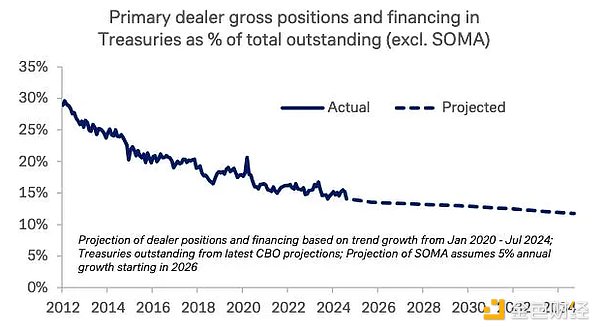
This is a chart from the Treasury Borrowing Advisory Committee (TBAC) presentation, Financial Resilience of Treasury Markets, October 29, 2024. This chart shows that the banking system holds a smaller and smaller share of total outstanding Treasury debt, and is therefore approaching the LCLoR. This is a problem because as the Fed sells (QT) and surplus country central banks sell (or stop investing) their net export earnings (de-dollarize), the marginal buyers in the Treasury market become volatile bond trading hedge funds.
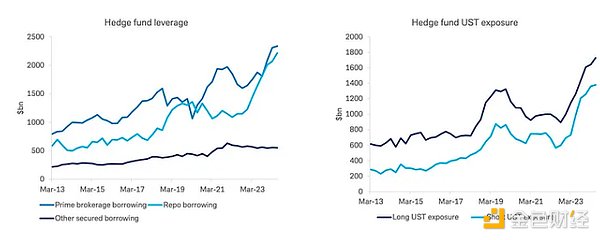
Here is another chart from the same presentation. As you can see, hedge funds are picking up the slack. But hedge funds are not real money buyers. They are doing a carry trade, buying cheap spot Treasuries and short Treasury futures contracts. The cash portion of the trade is financed by the repo market. A repo is the exchange of an asset (Treasury bill) for cash at a certain interest rate for a certain period of time. The repo market prices overnight funding using Treasuries as collateral based on the amount of commercial bank balance sheets available. As balance sheet capacity decreases, repo rates rise. If the cost of funding Treasuries rises, hedge funds can only buy more Treasuries when the price falls relative to the futures price. This ultimately means that the price of auctioned Treasuries must fall and yields rise. This is not what the Treasury wants to happen because it needs to issue more debt at increasingly cheaper prices.
Due to regulatory restrictions, banks cannot buy enough Treasuries and cannot finance hedge funds to buy Treasuries at affordable prices. This is why the Fed had to exempt banks from SLR again. It improves liquidity in the Treasury market and allows unlimited quantitative easing that can be targeted to the productive parts of the US economy.
If you’re not sure that the Treasury and the Fed understand the need for bank deregulation, TBAC spells out exactly what needs to be done on slide 29 of the same presentation:

Tracking the numbers
If Trumponomics works as I have just described, then we must focus on the amount of bank credit growth we expect to see. Based on the above examples, we know that QE for the rich works by increasing bank reserves, while QE for the poor works by increasing bank deposits. Thankfully, the Fed provides two data points for the entire banking system every week.
I created a custom Bloomie Index that is a combination of reserves and other deposits and liabilities <BANKUS U Index> .
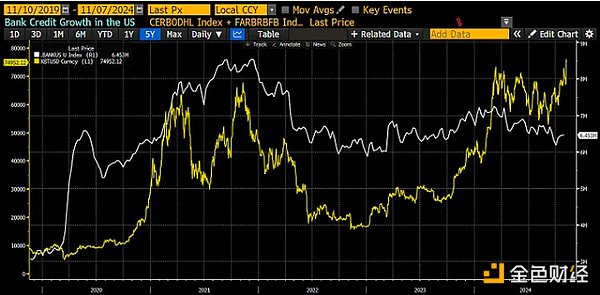
This is my custom index that tracks the amount of bank credit in the U.S. In my opinion, it is the most important money supply indicator. As you can see, sometimes it leads Bitcoin, like in 2020, and sometimes it lags Bitcoin, like in 2024.
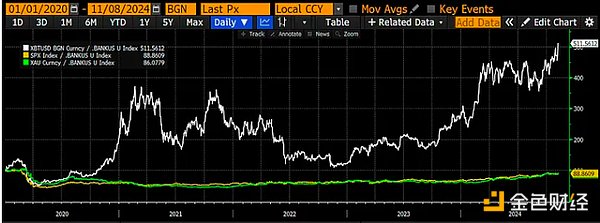
More important, however, is how an asset performs when it is subject to a contraction in the supply of bank credit. Bitcoin (white), the S&P 500 (gold), and gold (green) have all been divided by my bank credit index. These values are indexed to 100, and as you can see, Bitcoin has stood out, up over 400% since 2020. If you could only do one thing to combat the debasement of fiat currencies, make it Bitcoin. You can’t argue with math.
The way forward
Trump and his monetary lieutenants have made it very clear that they will pursue policies that weaken the dollar and provide the necessary funding for the reshoring of American industry. Given that the Republicans will control all three branches of government for the next two years, they can pass Trump's entire economic plan without any effective opposition from the Democrats. Mind you, I believe the Democrats will join the party of money printing, because what politician can resist giving out free stuff to their constituents?
Republicans will start by passing bills to encourage manufacturers of key goods and materials to expand domestic production. These bills will be similar to the CHIPS Act, the Infrastructure Act, and the Green New Deal passed by the Biden administration. As companies accept these government subsidies and receive loans, bank credit growth will surge. For those who fancy themselves as stock pickers, buy shares of public companies that make the things the government wants made.
At some point, the Fed will admit defeat and at least exempt US Treasuries and central bank reserves from the SLR burden. At that point, the path to unlimited quantitative easing will be clear.
The combination of legislated industrial policy and the SLR exemption will result in a massive influx of bank credit. I have shown that the velocity of money from such a policy is far higher than traditional Fed-supervised quantitative easing for the wealthy. We can therefore expect Bitcoin and cryptocurrencies to perform as well as, or better than, they did from March 2020 to November 2021. The real question is, how much credit will be created?
The coronavirus stimulus injected about $4 trillion in credit. This episode will be much worse. Defense and health care spending alone are growing faster than nominal GDP. They will continue to grow rapidly as the United States increases defense spending in response to the shift to a multipolar geopolitical environment. The share of people over 65 in the U.S. population will peak in 2030, which means that health care spending growth will accelerate between now and then. No politician can cut defense spending and health care because they will be quickly voted out of office. All this means that the Treasury will be busy pumping huge amounts of debt into the market quarter after quarter to keep the lights on. I have previously shown how quantitative easing combined with Treasury borrowing can make money velocity greater than 1. This deficit spending will increase the nominal growth potential of the United States.
Speaking of relocating American businesses back home, the cost of achieving this goal will also be in the trillions of dollars. The United States voluntarily handed over its manufacturing base to China when it allowed China into the World Trade Organization in 2001. In less than three decades, China has become the world's factory, producing the highest quality products at the lowest prices. Even companies that want to move their supply chains from China to so-called cheaper countries realize that the integration of so many suppliers along China's eastern seaboard is so deep and efficient that even if hourly wages are much lower in Vietnam, these companies still need to import intermediate parts from China to produce finished goods. In summary, reorienting supply chains to the United States will be a huge task, and if it must be done for political expediency, it will be very costly. I'm talking about high single-digit to low double-digit cheap bank financing that must be available to move production capacity from China to the United States.
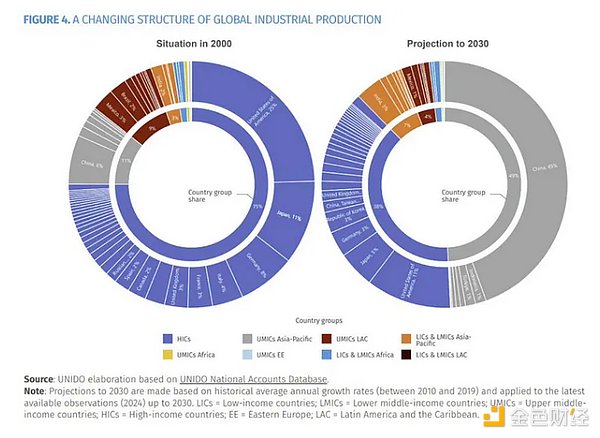 It took $4 trillion to reduce the debt-to-nominal GDP ratio from 132% to 115%. Suppose the US reduces it further to 70%, the level in September 2008. Using linear extrapolation alone, it would be equivalent to having to create $10.5 trillion of credit to achieve this deleveraging.
It took $4 trillion to reduce the debt-to-nominal GDP ratio from 132% to 115%. Suppose the US reduces it further to 70%, the level in September 2008. Using linear extrapolation alone, it would be equivalent to having to create $10.5 trillion of credit to achieve this deleveraging.
This is why Bitcoin hits $1 million , because the price is set at the margin. As the freely traded supply of Bitcoin decreases, the most fiat currency in history will be chased for safe haven not only from Americans, but also from the Chinese, Japanese, and Western Europeans. Invest more, keep more.
If you doubt my analysis of the impact of quantitative easing on the poor, just read the economic history of China over the past thirty years and you will understand why I call the new economic system under US rule "American capitalism with Chinese characteristics."







